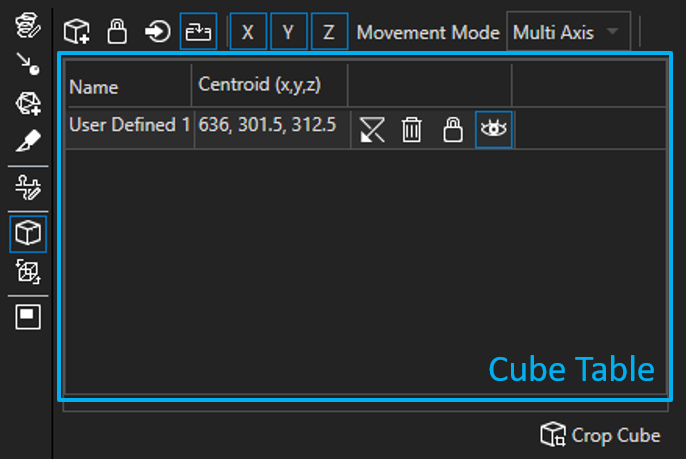Change the Movement Mode
There are options to allow translation of cubes only along designated axial directions. Single Axis, Multi Axis, or Longest Axis mode may be selected from the Select Movement Mode drop-down menu. The directions along which translation is allowed are outlined in blue; for example,  indicates that translation in the x- and y-directions is allowed, but translation in the z-direction is locked. Note that Movement Modes only un/lock changes in position and NOT size, so the centroid of a cube may still be moved along a locked direction if the size/extent of the cube along the locked direction is changed.
indicates that translation in the x- and y-directions is allowed, but translation in the z-direction is locked. Note that Movement Modes only un/lock changes in position and NOT size, so the centroid of a cube may still be moved along a locked direction if the size/extent of the cube along the locked direction is changed.
Single Axis
To enter the Single Axis Movement Mode, select Single Axis from the Select Movement Mode drop-down menu. All cubes may only be translated in one axial direction in this mode. Click on the Allow/Restrict Movement icon for the desired axis of translation ( ,
,  , or
, or  ) to set it as the unlocked axis.
) to set it as the unlocked axis.
Multi Axis
Multi Axis is the default Movement Mode, but it may also be chosen by selecting Multi Axis from the Select Movement Mode drop-down menu. Toggle the Allow/Restrict Movement icons ( ,
,  , or
, or  ) to un/lock movement along any combination of axial directions, though movement along at least one direction must be allowed.
) to un/lock movement along any combination of axial directions, though movement along at least one direction must be allowed.
Longest Axis
To enter the Longest Axis Movement Mode, select Longest Axis from the Select Movement Mode drop-down menu. Cubes may be translated in any axial direction in Longest Axis mode but only along one axial direction at a time: as the central red sphere of a cube is dragged, the cube is translated in the axial direction closest to the direction that the mouse is dragged.
Revert a cube
Click on the Revert Cube icon  in a cube's row of the Cube Table to return the cube to its initial, automatically generated size and position.
in a cube's row of the Cube Table to return the cube to its initial, automatically generated size and position.
Revert a cube via the Recipe Console
The Revert Cube option is also available in the Regions of Interest table in the Recipe Console tab of the Analysis Panel. To show the Regions of Interest table, click on the Recipe Console tab in the Analysis Panel, then the Expand icon  next to Input and Output in any recipe, and then the Expand icon
next to Input and Output in any recipe, and then the Expand icon  next to Regions of Interest.
next to Regions of Interest.
Remove a cube
Click the Remove Cube icon  in a cube's row of the Cube Table to remove the cube.
in a cube's row of the Cube Table to remove the cube.
Remove a cube via the Recipe Console
The Remove Cube option is also available in the Regions of Interest table in the Recipe Console tab of the Analysis Panel. To show the Regions of Interest table, click on the Recipe Console tab in the Analysis Panel, then the Expand icon  next to Input and Output in any recipe, and then the Expand icon
next to Input and Output in any recipe, and then the Expand icon  next to Regions of Interest.
next to Regions of Interest.
Un/Hide a cube
Click the Un/Hide Cube icon  in a cube's row of the Cube Table to hide or show that cube.
in a cube's row of the Cube Table to hide or show that cube.
Un/Hide cubes via the Recipe Console
Cubes may also be shown and hidden (as a group, not individually) from the Regions of Interest table in the Recipe Console tab of the Analysis Panel. To un/hide cubes by way of the Recipe Console, click on the Recipe Console tab in the Analysis Panel, then on the Expand icon  next to Input and Output in any recipe, and then on the Show ROIs icon (
next to Input and Output in any recipe, and then on the Show ROIs icon ( or
or  ) next to Regions of Interest.
) next to Regions of Interest.
Show/Hide cube labels
Click on Show Cube Labels icon  to toggle on/off the display of cube names in the Image Viewer.
to toggle on/off the display of cube names in the Image Viewer.
Zoom to a cube
Select a cube, and then click the Zoom to Cube icon  to zoom to the selected cube in the Image Viewer (if in 3D View) or in the 3D pane (if in 3D Plane View).
to zoom to the selected cube in the Image Viewer (if in 3D View) or in the 3D pane (if in 3D Plane View).
Crop out a cube
Select a cube, and then click the Crop Cube button at the bottom of the interface to generate a new image that contains only the image data lying within the selected cube. This cropped image is displayed in the Image Viewer and has a thumbnail that appears in the Image Explorer once it has been generated, but the cropped image is NOT automatically saved.
Image credits
Philipp Keller, Howard Hughes Medical Institute, Janelia Farms Research Campus, Ashburn VA; Cell Tracking Challenge, http://www.celltrackingchallenge.net/datasets.html
Related articles
-
Page:
-
Page:
-
Page:
-
Page:
-
Page:


